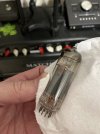Orvillain
Power User
I've noticed for my tastes, I like the headroom to hit around -8dB. Too close to 0dB and it starts to be flubby and not my thing.
And I would imagine the headroom and how hard you're hitting the final outputs, don't really relate to one another. You could crank the master and turn down the level.... and you're still smashing the amp... it's just the final output level gets turned down.
And I would imagine the headroom and how hard you're hitting the final outputs, don't really relate to one another. You could crank the master and turn down the level.... and you're still smashing the amp... it's just the final output level gets turned down.


 . (About the amount of gain)
. (About the amount of gain)